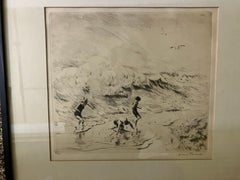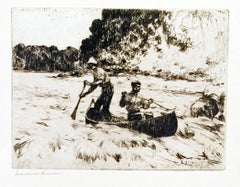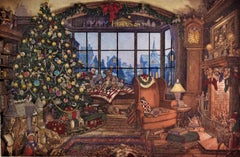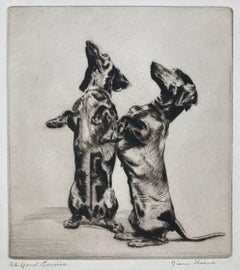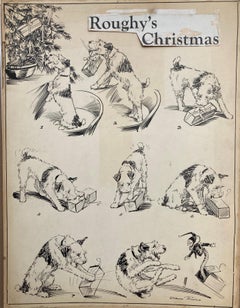Diana Thorne Art
to
1
Overall Width
to
Overall Height
to
1
1
1
1
1
1
10,083
2,779
1,379
1,375
1
1
Artist: Diana Thorne
Diane Thorne Children at The Beach
By Diana Thorne
Located in San Francisco, CA
Diane Thorne: 1895-1963. Listed Canadian artist who was born in Russia. She is best known for her etchings of dogs and children. She has auction results as high as $1300 for a single...
Category
1940s American Realist Diana Thorne Art
Materials
Etching
Related Items
RUNNING THE RAPIDS
By Frank Benson
Located in Portland, ME
Benson, Frank. RUNNING THE RAPIDS. Paff 269. Etching, 1927. Edition of 150. Signed in pencil. Printed on Whatman paper. 5 7/8 x 7 3/4 inches (plate), 8 1/2 x 10 5/8 inches (sheet). A...
Category
1920s American Realist Diana Thorne Art
Materials
Etching
Fireside Christmas
Located in San Francisco, CA
This artwork titled "Fireside Christmas" c. 1985 is an original color etching by American artist Scott Fitzgerald. It is hand signed, titled and numbered 158/250 in pencil by the artist. Published and printed by the artist. The image (plate mark) size is 11.5 x 17.65 inches, sheet size is 19.25 x 25.25 inches. it is in excellent condition, has never been framed.
About the artist:
Scott Fitzgerald received his Master’s Degree in Arts from California State University Fullerton, and went on to teach drawing and printmaking for 2 years at the university.
During his college years, he focused his study in contemporary art and photography, creating mixed media works often with social comments. It was not until the sophomore year, he discovered the traditional art of etching in his printmaking class. Immediately, he embraced the complex and difficult technical process of making prints from etching on copper plates.
Scott Fitzgerald established himself as a prominent printmaker in the next few years. With a strong interest in history, he accepted a commission to produce a series of etching depicting 15 Orange County historical landmarks. Besides producing very intricate prints in various sizes, he has engaged in many special projects. He worked with renowned English printer John Randle to produce a group of etchings...
Category
Late 20th Century American Realist Diana Thorne Art
Materials
Etching
Music Medicine and Sport Signed 1966 Limited Edition Etching
By Warrington Colescott
Located in Rochester Hills, MI
Warrington Colescott
Music Medicine and Sport- 1966
Print - etching 18'' x 17½'' inches
Paper Size 30" x 22" inches
Edition: signed in pencil, titled and numbered 2/30
Category
1960s American Realist Diana Thorne Art
Materials
Etching
$1,600 Sale Price
20% Off
H 30 in W 22 in D 1 in
20th century drypoint etching figurative animal print black and white signed
By John Edward Costigan
Located in Milwaukee, WI
"Boy With Cows" is an original drypoint etching by John Edward Costigan. It depicts a young boy with three cows standing in a watering hole. The artist si...
Category
1930s American Realist Diana Thorne Art
Materials
Drypoint, Etching
CALIFORNIA VISTA
By Harold Lukens Doolittle
Located in Santa Monica, CA
HAROLD L. DOOLITTLE (1883 – 1974)
CALIFORNIA VISTA, 1923
Aquatint signed and titled in pencil. 8 7/8 x 6 7/8 inches. Sheet 11 x 14 inches. Good condi...
Category
1920s American Realist Diana Thorne Art
Materials
Aquatint
Union Street, San Francisco
By Edith (Mark) Milsk
Located in San Francisco, CA
This artwork titled "Union Street, San Francisco" is an original etching on creme wove paper by American artist Edith (Mark) Milsk, 1899-1982. It is hand signed and titled in pencil by the artist. The plate mark (Image) size is 5.5 x 3.65 inches, framed size is 16.5 x 13.40 inches. Custom framed in a red Oak frame, with beige matting. It is in excellent condition.
About the artist:
Edith Milsk...
Category
Mid-20th Century American Realist Diana Thorne Art
Materials
Etching
'The Connectors' — Vintage American Realism, New York City
By James Allen
Located in Myrtle Beach, SC
James Allen, 'The Connectors', 1934, etching, edition not stated, Ryan 66. Signed in pencil. A superb, richly-inked impression, on handmade, cream laid paper, with margins (1/2 to 1...
Category
1930s American Realist Diana Thorne Art
Materials
Etching
$5,200
H 12.88 in W 9.82 in
Two Boys on a Beach No.1
By Paul Cadmus
Located in London, GB
Etching
Signed (lower right) and dedicated ‘To Carmencita, 1939’ (lower left)
From edition of 75
13cm x 18cm (plate size), (40cm x 44cm framed)
Cadmus was an American artist known ...
Category
1930s American Realist Diana Thorne Art
Materials
Etching
Vanity
By Louis Russomanno
Located in San Francisco, CA
This artwork titled "Vanity" 1980 is an original sepia etching by American artist Louis Russomanno, b.1946. It is hand signed, titled and numbered 113/185 in pencil by the artist. Th...
Category
Late 20th Century American Realist Diana Thorne Art
Materials
Etching
'The Elevated, East 42nd Street, New York' — 1910 American Realism
By William Monk
Located in Myrtle Beach, SC
William Monk, 'The Elevated, East 42nd Street, New York', etching, 1910. Signed in pencil and titled in the bottom right sheet corner. Signed in the plate, lower right. A superb, ric...
Category
1910s American Realist Diana Thorne Art
Materials
Etching
$1,200 Sale Price
20% Off
H 10.38 in W 13.88 in
THE BURRO STATION - Large Etching with Incredible Detail. One of a Pair
By Reynold Weidenaar
Located in Santa Monica, CA
REYNOLD WEIDENAAR (1915 - 1985)
THE BURRO STATION, 1946, Etching and drypoint on paper, Signed and titled in pencil from an edition of unknown size. Plate: 17" x 13": Sheet: 20.75" x 15.75". One of a pair of large format Mexican etchings...
Category
1940s American Realist Diana Thorne Art
Materials
Etching
A Burro Train, New Mexico
By Peter Moran
Located in San Francisco, CA
This artwork titled "A Burro Train, New Mexico" 1880 is an original etching on Laid paper by noted British/American artist Peter Moran, 1841-1914. It is signed in the plate as issue. The plate mark (Image) size is 9.15 x 6.5 inches, framed size is 14.75 x 18.75 inches. It is framed in a wooden silver frame, with light grey matting. It is in excellent condition, especially considering the age. I like to mention that example of this particular etching is held in the following museums, including, The Toledo Museum Of Art, Toledo, The British Museum, London and The Smithsonian Museum Of Art, Washington D.C. It was also illustrated in American Art Review, volume #2 1881, page 163.
About the artist:
The younger brother of Thomas Moran, Peter Moran was a painter-etcher best known for his Romantic sensibility and landscape compositions incorporating animals. The Moran family immigrated to the United States from England in 1844, when Peter was three. He began his artistic career as an apprentice to a lithographic firm and eventually studied painting with his brothers Edward and Thomas. He was influenced by the animal paintings of Rosa Bonheur and Constant Troyon and visited England in 1863 to see those of Edwin Landseer.
Moran took up etching in 1874, using that medium to record genre scenes that he observed while traveling in New Mexico and Arizona in 1881 on an ethnographic expedition to study Pueblo Indian culture. He later returned to the Southwest in 1890 as an artist for the Bureau of Indian Affairs.
In 1882, Moran joined Henry R. Poore, an artist friend, on a visit to Taos Pueblo where the two were given a room and spent a week watching the activities associated with the harvest. Poore recounted the details of their travels in an article titled "A Harvest with the Taos Indians...
Category
Late 19th Century American Realist Diana Thorne Art
Materials
Etching
Previously Available Items
AT YOUR SERVICE
By Diana Thorne
Located in Santa Monica, CA
DIANA THORNE (1895 - 1963)
AT YOUR SERVICE - Drypoint, signed and titled in pencil. Image 9 7/8 X 8 7/8, sheet 11 1/4 x 12 3/4 inches. In good condition.
Diana Thorne is a well known artist who specialized in images of Dogs.
Please see a large pen and ink Thorne illustration cartoon on the 1stdibs website sold by this dealer.
Item # LU41139121622
The following biography is by Frank J. Leskovitz ©1995-2022
Diana Thorne was born Ann Woursell on October 7, 1895 in Odessa, Russia. (Some evidence indicates that she may have actually been born in 1894.) In her youth, Thorne spent time in Winnipeg, Canada and later on a farm in Calgary, Canada. She was to eventually become one of America's most recognized canine artists. Thorne began drawing all her favorite four-legged creatures as a young child. She was the oldest child in a Jewish family of four girls and two boys. Her siblings were Abraham, Paula, Judith, Samuel, and Katherine. Thorne's parents were Chaim and Rose Woursell. During this period, Jews in Russia were experiencing severe oppression and physical attacks. The situation seemed hopeless. Canada opened its doors to immigrants fleeing Russia, offering free homestead land in the West. The family left Canada for Germany around 1912 where Thorne took her first formal art studies at the Imperial Academy in Munich and Charlottenburg Technical College in Berlin. The First World War began two years later and Thorne and her family were subsequently detained by the German government. They managed to escape to England, where Thorne was said to have supported herself as a reporter, librarian, writer, bicycle shop owner, and typewriter repair person. At this time she began her first experiments in both illustration and etching and was said to have studied with artist William Strang. On September 27, 1920, Thorne and several of her family members arrived in the United States. Her first published etching, titled "Rollin' Home", was well received in 1926. From this point on, she became an established artist. Thorne began commercial artwork in New York City in 1929. In her private life, she was known as Mrs. Arthur North, claiming to reside at times in Boston, Massachusetts, Philadelphia, Pennsylvania or Connecticut. (The pseudonym Thorne originated from an anagram of the name North.) There is evidence that Arthur North was actually an alias of artist Carton Moore-Park (1877-1956). This ruse allowed Thorne and Moore-Park to present themselves as a married couple, even though Moore-Park was already married. Frequently, biographies of the artist are filled with inaccuracies supplied by Thorne herself, such as referring to her father as a Scotsman or claiming to be Canadian born, which served to conceal the true details of her past.
The author-illustrator of more than forty books and illustrator of more than fifty, Thorne's main reason for success was a total dedication to her drawing and a deep love for her subject matter. A sportswoman and owner of dogs herself, Thorne illustrated (and often authored) children's books dealing with dogs and animal life. Thorne's longtime publisher was the Saalfield Publishing Company of Akron, Ohio, once a leading publisher of children's literature and paper novelties. In her etchings of dogs, Thorne had the ability to show motion and action. A combination of whirling lines with solid lines and light and dark tones brings to the viewer's eyes the dog in motion. Thorne’s dog etchings are admired because they capture the humor and energy transpired by man and dog. In addition to dog etchings, she is also known for a series of socially sensitive etchings published in a 1928 portfolio, "The Human Comedy". Thorne also executed a series of popular sports etchings featuring topics such as skiing and boxing which were characterized by multiple images engraved on the same plate. Very much in demand as an animal portrait painter, Thorne illustrated some of the most famous dogs in America, including Franklin D. Roosevelt's Scottie "Fala" and Admiral Richard E. Byrd's "Igloo", the terrier who accompanied him on his famous Antarctic Expedition. Diana Thorne was most active between the 1920s and 1940s. Sadly, she was diagnosed as mentally ill and committed to New York City's Belleville Hospital in September 1962. Thorne died in July 196
Diana Thorne's work appeared in numerous magazines and newspapers including The American Magazine, The Literary Digest, Liberty, The Woman's Home Companion, The Household Magazine, Maclean's, Home Arts, Nature Magazine, National Home Monthly, This Week Magazine, The American Kennel Gazette, The New York Times, The Boston Post, and The New York Herald Tribune. Throughout the 1940s she was a regular contributer of artwork and written articles to the Christian Science Monitor. Thorne was widely known in New York and London for her artwork. Noted galleries such as Kennedy & Company and the Schwartz Galleries of New York City, the Gage Gallery of Cleveland, and the Hudson Galleries of Detroit carried many of her etchings, which were produced in editions ranging from fifty to one hundred signed impressions. Her print, "Pan of Puck Hill", was featured in England's Fine Prints of the Year and was also selected as one of the Graphic Arts Society's Fifty Best Prints of the Year by the Chicago Society of Etchers. Thorne received widespread acclaim for her unique etchings, sketches, watercolors, sculpture, lithography, and paintings, which were exhibited in the principal cities of the United States and England. She had her first New York City showing in April 1929 at the Schwartz Galleries in an exhibition titled, "Drypoints and Drawings by Diana Thorne". In 1930, her work was presented at three solo exhibitions. The first took place at the Vose Galleries of Boston. This was followed by additional exhibitions in New York City at Milch Galleries and the Fifty-Sixth Street...
Category
1930s Realist Diana Thorne Art
Materials
Drypoint
ROUGHY’S CHRISTMAS - Original Illustration 19 1/4" x 14 1/2"
By Diana Thorne
Located in Santa Monica, CA
DIANA THORNE (1895-1963) ROUGHY’S CHRISTMAS c. 1936
Original pen & ink illustration on board. Signed in ink lower right. Image 19 1/4 x 14 ½”. Diana Thorne is well known for her depiction and illustrations of dogs. Her dog etchings are highly collectable.
Please see the Diana Thorne etching listing below also on 1stdibs sold by this dealer LU411310493262 "At Your Service"
The following biography is by Frank J. Leskovitz ©1995-2022
Diana Thorne was born Ann Woursell on October 7, 1895 in Odessa, Russia. (Some evidence indicates that she may have actually been born in 1894.) In her youth, Thorne spent time in Winnipeg, Canada and later on a farm in Calgary, Canada. She was to eventually become one of America's most recognized canine artists. Thorne began drawing all her favorite four-legged creatures as a young child. She was the oldest child in a Jewish family of four girls and two boys. Her siblings were Abraham, Paula, Judith, Samuel, and Katherine. Thorne's parents were Chaim and Rose Woursell. During this period, Jews in Russia were experiencing severe oppression and physical attacks. The situation seemed hopeless. Canada opened its doors to immigrants fleeing Russia, offering free homestead land in the West. The family left Canada for Germany around 1912 where Thorne took her first formal art studies at the Imperial Academy in Munich and Charlottenburg Technical College in Berlin. The First World War began two years later and Thorne and her family were subsequently detained by the German government. They managed to escape to England, where Thorne was said to have supported herself as a reporter, librarian, writer, bicycle shop owner, and typewriter repair person. At this time she began her first experiments in both illustration and etching and was said to have studied with artist William Strang. On September 27, 1920, Thorne and several of her family members arrived in the United States. Her first published etching, titled "Rollin' Home", was well received in 1926. From this point on, she became an established artist. Thorne began commercial artwork in New York City in 1929. In her private life, she was known as Mrs. Arthur North, claiming to reside at times in Boston, Massachusetts, Philadelphia, Pennsylvania or Connecticut. (The pseudonym Thorne originated from an anagram of the name North.) There is evidence that Arthur North was actually an alias of artist Carton Moore-Park (1877-1956). This ruse allowed Thorne and Moore-Park to present themselves as a married couple, even though Moore-Park was already married. Frequently, biographies of the artist are filled with inaccuracies supplied by Thorne herself, such as referring to her father as a Scotsman or claiming to be Canadian born, which served to conceal the true details of her past.
The author-illustrator of more than forty books and illustrator of more than fifty, Thorne's main reason for success was a total dedication to her drawing and a deep love for her subject matter. A sportswoman and owner of dogs herself, Thorne illustrated (and often authored) children's books dealing with dogs and animal life. Thorne's longtime publisher was the Saalfield Publishing Company of Akron, Ohio, once a leading publisher of children's literature and paper novelties. In her etchings of dogs, Thorne had the ability to show motion and action. A combination of whirling lines with solid lines and light and dark tones brings to the viewer's eyes the dog in motion. Thorne’s dog etchings are admired because they capture the humor and energy transpired by man and dog. In addition to dog etchings, she is also known for a series of socially sensitive etchings published in a 1928 portfolio, "The Human Comedy". Thorne also executed a series of popular sports etchings featuring topics such as skiing and boxing which were characterized by multiple images engraved on the same plate. Very much in demand as an animal portrait painter, Thorne illustrated some of the most famous dogs in America, including Franklin D. Roosevelt's Scottie "Fala" and Admiral Richard E. Byrd's "Igloo", the terrier who accompanied him on his famous Antarctic Expedition. Diana Thorne was most active between the 1920s and 1940s. Sadly, she was diagnosed as mentally ill and committed to New York City's Belleville Hospital in September 1962. Thorne died in July 196
Diana Thorne's work appeared in numerous magazines and newspapers including The American Magazine, The Literary Digest, Liberty, The Woman's Home Companion, The Household Magazine, Maclean's, Home Arts, Nature Magazine, National Home Monthly, This Week Magazine, The American Kennel Gazette, The New York Times, The Boston Post, and The New York Herald Tribune. Throughout the 1940s she was a regular contributer of artwork and written articles to the Christian Science Monitor. Thorne was widely known in New York and London for her artwork. Noted galleries such as Kennedy & Company and the Schwartz Galleries of New York City, the Gage Gallery of Cleveland, and the Hudson Galleries of Detroit carried many of her etchings, which were produced in editions ranging from fifty to one hundred signed impressions. Her print, "Pan of Puck Hill", was featured in England's Fine Prints of the Year and was also selected as one of the Graphic Arts Society's Fifty Best Prints of the Year by the Chicago Society of Etchers. Thorne received widespread acclaim for her unique etchings, sketches, watercolors, sculpture, lithography, and paintings, which were exhibited in the principal cities of the United States and England. She had her first New York City showing in April 1929 at the Schwartz Galleries in an exhibition titled, "Drypoints and Drawings by Diana Thorne". In 1930, her work was presented at three solo exhibitions. The first took place at the Vose Galleries of Boston. This was followed by additional exhibitions in New York City at Milch Galleries and the Fifty-Sixth Street...
Category
1930s Modern Diana Thorne Art
Materials
Pen
Diana Thorne art for sale on 1stDibs.
Find a wide variety of authentic Diana Thorne art available for sale on 1stDibs. If you’re browsing the collection of art to introduce a pop of color in a neutral corner of your living room or bedroom, you can find work that includes elements of purple and other colors. You can also browse by medium to find art by Diana Thorne in lithograph, drypoint, engraving and more. Much of the original work by this artist or collective was created during the 20th century and is mostly associated with the modern style. Not every interior allows for large Diana Thorne art, so small editions measuring 9 inches across are available. Customers who are interested in this artist might also find the work of Kono Bairei, Jules Gouffe, and Matsui Yuoku. Diana Thorne art prices can differ depending upon medium, time period and other attributes. On 1stDibs, the price for these items starts at $350 and tops out at $500, while the average work can sell for $350.
